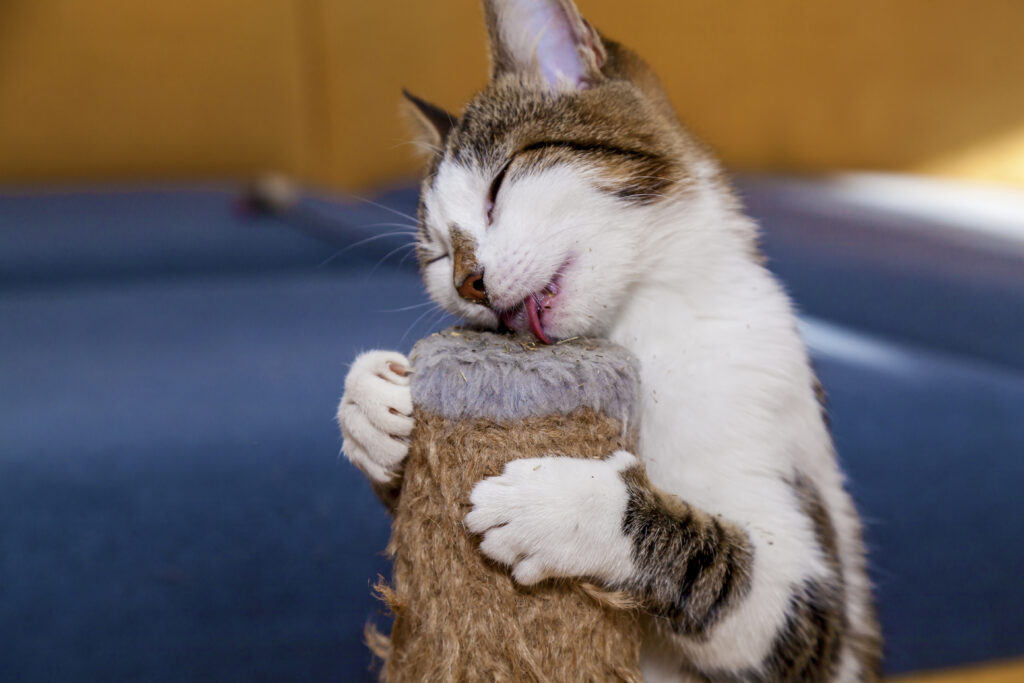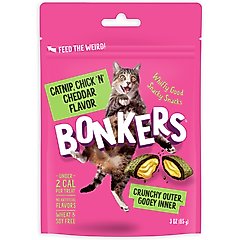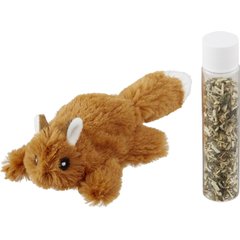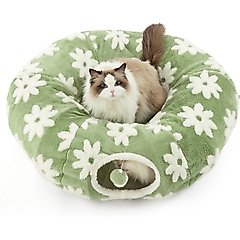What Is Catnip? A Guide to Your Cat’s Favorite Treat

Photo by Oleg_0 / iStock / Getty Images Plus
Dilated pupils. High-powered zoomies. Complete, utter bliss. This can only mean one thing: Your cat’s been given catnip.
This aromatic herb sends our feline friends into a fun-filled frenzy. But what is catnip, exactly?
We spoke with veterinarians to learn more about this green plant and why our cats love it so much.
What Is Catnip?
Catnip, or Nepeta cataria, is a perennial plant that is a part of the mint family. It’s native to central Europe, Asia, and North Africa, and it’s sometimes called catnep, catsworth, or field balm. The word itself comes from “nip,” or “a small quantity of liquor” that intoxicates your cat.
The primary ingredient in catnip that causes bizarre, behavior-altering reactions in cats is the compound known as nepetalactone.
Catnip leaves are used in human products, too, like herbal teas, calming bath and body products, and even natural bug repellents. Catnip flowers have a long history of medicinal use to relieve coughs, sore throats, and fevers in humans.
What Does Catnip Do to Cats?
Catnip can make even the tamest feline go wild. But what happens when our silly felines get a sniff or lick of this green herb?
When cats smell catnip, it binds to receptors in their nasal tissue, which stimulates sensory neurons that trigger a temporary, euphoric response, says Sabrina Kong, DVM, veterinary consultant at We Love Doodles.
“Think of it as a feline ‘happy button,’” she says, noting that about 50–70% of cats inherit a genetic sensitivity to catnip, “which explains why some go wild for it and others seem indifferent. The reaction is instinctive, harking back to their wild ancestors, who used similar plant chemicals in communication and play.”
Upon sniffing or eating catnip, your cat may become either a furry ball of energy or a content, calm kitty:
- If smelling it, you might see them rolling, rubbing, or doing zoomies.
- If eating it, you may notice them become more mellow.
The effect lasts around 15 minutes, Dr. Kong says. If your cat doesn’t respond to it, they may be too young (cats don’t react to it until they’re around 6 months old) or they’re part of the roughly one in three cats who don’t have a reaction, says Brad Krohn, DVM, veterinarian at The Cat Behavior Clinic in Seattle.
Why Do Cats Like Catnip?
For cats who do partake in catnip, they love it for its intoxicating effects.
“Nepetalactone mimics natural feline pheromones, particularly those linked to mating behaviors,” Dr. Kong says. “This tricks the brain into a brief state of excitement or relaxation, depending on the cat.”
Dr. Kong says you may notice the following behaviors:
- Rolling
- Rubbing against surfaces
- Purring
- Leaping
- Mimicking hunting
- Vocalizing excitedly
- Mating behaviors
- Drooling
- Grooming excessively
- Kneading their paws
“A cat might sprint around the room chasing imaginary prey, then collapse into a blissful nap,” she says. “Rarely, overstimulation can lead to mild aggression, like hissing, but these reactions are self-limiting and harmless.”
Dr. Krohn recommends catnip to enrich your cat’s day-to-day—kind of like their brain throwing a temporary party to break up the monotony of life indoors. It can also help them de-stress by encouraging exercise and exhausting their prey drive.
Due to the feel-good chemical release in the brain, cats behave more playfully, which induces their most fear-free state, Dr. Krohn says. This can even lead to a more confident cat over time.
It’s not surprising then that some shy cats can benefit from being given catnip daily.
“Experiencing play and this improved mood state can really help a timid cat come out of their shell—or out from under the bed,” he notes.
Types of Catnip
There are several types of catnip available for our furry friends. Depending on the variety as well as your cat’s individual response, you can use it to encourage physical activity, calm them, and even to train them.
Dr. Kong breaks down the types of catnip available and their formulations, including:
- Dried leaf catnip: Dried leaf catnip is the gold standard—potent, versatile, and perfect for stuffing toys. If your furry friend doesn’t react to regular catnip, consider a silvervine and catnip blend.
- Catnip sprays: Catnip sprays are milder than dried leaf catnip and ideal for timid cats, as well as things like pet beds and cat scratchers. You can also use them to redirect your cat to scratch somewhere they’re supposed to (like a scratching post) instead of your sofa or chair.
- Fresh catnip plants and treats: You might wonder, can cats eat catnip? The answer is absolutely. You can grow your own catnip plants or just buy ready-to-eat catnip treats.
- Catnip-infused toys: Catnip-infused toys come pre-filled with catnip, which are great for low-maintenance play.
Recommended Products
When deciding on the best kind of catnip, Dr. Kong advises choosing products with no synthetic fillers. Also avoid concentrated oils or essential oil blends marketed as catnip.
“[Concentrated catnip oils] often contain artificial additives or alcohol bases that can irritate a cat’s skin or digestive tract,” Dr. Kong explains. She says pure nepetalactone extracts are unnecessary, since natural dried catnip is safer and equally effective.
How to Give Catnip to Cats
Want to see if your cat goes cuckoo for catnip?
Here are a few ways you can offer them catnip:
- Sprinkle dried leaf catnip on their toys or stuff refillable toys with it.
- Sprinkle dried leaf catnip on their food.
- Spray it on their beds, carriers, cat trees, and other cat furniture.
- Feed your cat catnip treats or catnip plants.
Recommended Products
Is Catnip Bad for Cats?
Catnip is safe in moderation, since it’s nontoxic, Dr. Kong says. She recommends a quarter to half a teaspoon of dried catnip up to twice a week to prevent desensitization. For anxious felines, opt for catnip-infused toys to control dosing.
“Always let cats choose whether to engage; some simply ignore it, and that’s normal,” she says. “Avoid forcing interaction, as stress negates the benefits.”
Overindulgence in catnip may cause symptoms, such as:
Severe issues are rare but supervise your cat’s initial exposure, Dr. Kong says. Unused catnip should be stored in an airtight container to maintain its potency.
FAQs for Can Cats Eat Catnip
Q: How long does catnip last?
A: According to Dr. Kong, the effects of catnip are short-lived, lasting about 10–15 minutes.
Q: Can cats overdose on catnip?
A: No. Catnip isn’t toxic, so cats can’t overdose on it in the traditional sense. They’re able to self-regulate and walk away once saturated. However, overindulging can result in vomiting or diarrhea, Dr. Kong says.
Q: Can kittens have catnip?
A: Technically, yes. However, kittens younger than 6 months old typically lack the neurological maturity to respond to catnip.
Q: Does catnip make cats high?
A: Sort of. But catnip isn’t a drug, and the “high” it produces isn’t the same kind of high that humans experience with marijuana, for example. Catnip can create a euphoric experience for cats, and its effects may make them act “high.”
Attributions
This content was medically reviewed by Hannah Hart, DVM, Chewy veterinarian.










